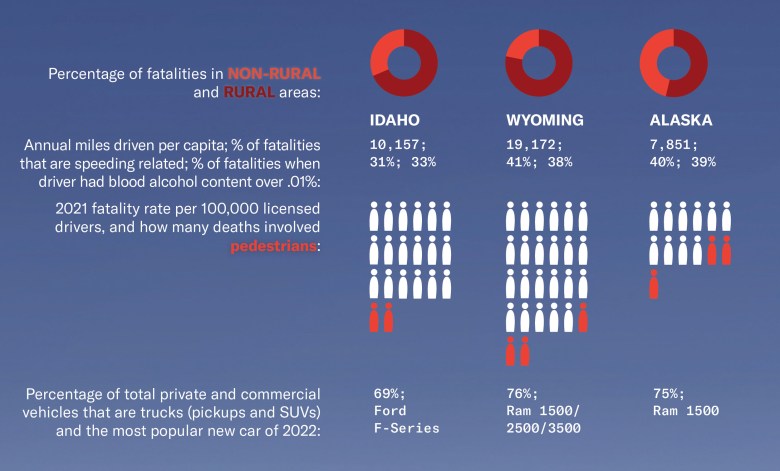On July 29 last year,17-year-old Magnus White left his Boulder, Colorado, home for a final training ride before competing in the UCI World Cycling Championships in Ireland. As he pedaled back to town in the shoulder lane of the Diagonal Highway, a major thoroughfare, 23-year-old Yeva Smilianska swerved out of her lane onto the shoulder. Her Toyota Matrix slammed into White, throwing him into a fence and killing him.

White was just one of the 6,800 motorists, passengers, bicyclists and pedestrians killed on the roads, highways and streets of the Western U.S. during the first nine months of 2023 alone. In the U.S., this region’s per capita death rate is rivaled only by that of the Deep South.
Every fatal crash has its own cause, whether it’s careless or distracted driving, high speeds, adverse conditions or any of a myriad other factors. But the regional trends — especially an alarming rise in pedestrian fatalities — have deeper roots: highways designed to move cars quickly, rather than safely; a hunger for larger and larger vehicles; growing wealth inequality (and infrastructure disparities); and, most fundamentally, Americans’ car-centric culture, whose public policies and infrastructure value automobiles over humans at almost every turn.


18.5%; 11.2%; 5.5%
Percent of drivers involved in fatal crashes in the U.S. in 2021 that were, respectively: driving too fast for conditions; under the influence of alcohol, drugs or medication; or driving while distracted.
Big car arms race: As motorists demand larger vehicles, auto manufacturers heed the call. The weight of the average car on U.S. roads has ballooned by 34% since 1980, with height and width also increasing. While bigger cars typically are safer for their occupants, they pose a greater hazard to anyone or anything smaller they may collide with, a phenomenon known as “crash incompatibility.” A 2004 study found that for every life saved by a motorist who switched from a car to a light truck (SUV or pickup), 4.3 other drivers, pedestrians and cyclists were killed.
28%: Percent by which a collision with an SUV is more likely to kill a car’s occupants than one with another passenger car.


Growing risks: While traffic deaths have been increasing nationwide alongside population growth, the West’s highways appear to be getting even deadlier over time, especially for pedestrians.
90 days
Jail sentence for the motorist who struck and killed Christine Embree, who was riding her bike with her 16-month-old daughter in Southern California, in August 2022.
A 2008 study found that an SUV traveling at 24 mph would have twice the impact force on a pedestrian’s brain as a sedan traveling the same speed.
A 2004 study found that pedestrians hit by a light truck rather than a car are two to three times more likely to die.

The inequity of highway hazards: Traffic crashes kill people of color and those with lower incomes at a disproportionately high rate. Indigenous people are twice as likely as white people to die on American highways, and the risk is even higher for people who are walking. Many drivers cannot afford larger cars that are safer for their occupants, leaving them at the mercy of ever larger and more costly SUVs. At the same time, low-income neighborhoods are less likely to have sidewalks, adequate street lighting or traffic-calming devices, making pedestrians more vulnerable. A 2019 study found that for every $1,000 decrease in the median income of a U.S. census tract, pedestrians are 1% more likely to be killed by a motorist.
58%
Percent of transportation-related greenhouse gas emissions in the U.S. attributable to light-duty vehicles, including passenger cars, pickups and SUVs — about 14 times more than aircraft produce.
SOURCES: National Highway Traffic Safety Administration; Environmental Protection Agency; Governors Highway Safety Association; Edmunds; Ford Motor Co.; Fuelly; “The ‘Arms Race’ on American roads: The effect of sport utility vehicles and pickup trucks on traffic safety,” by M.J. White; “The effect of front-end vehicle height on pedestrian death risk,” by Justin Tyndall; “Race and income disparities in pedestrian injuries: Factors influencing pedestrian safety inequity,” by J. Roll and N. McNeil; Los Angeles Times; Smart Growth America; Insurance Institute for Highway Safety.
Illustrations by Hannah Agosta/High Country News
Jonathan Thompson is a contributing editor at High Country News. He is the author of Sagebrush Empire: How a Remote Utah County Became the Battlefront of American Public Lands.
This article appeared in the March 2024 print edition of the magazine with the headline “Highways of hazard.”




